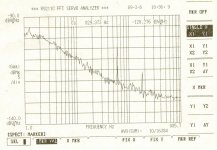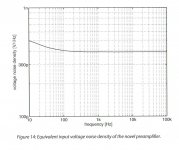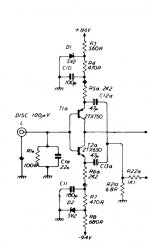<cut>
Change the fab and the LF excess noise may blow the device noise performance off the chart, and that with a no (or minimum) impact on the switching device data sheet performance.
Before the buyout, they could be confident of retaining control of that: they owned the fab. I think the use of 'reproducible' was an expression of confidence in that. Moreover, their track record was of consistent low noise performance over decades of making parts like the ZTX550.
Still it's a little disconcerting when they say "trust us we know how to make low noise transistors reproducibly," but then refuse to guarantee noise performance or specify it, even a "typical" value, on the product datasheet.
What it means is: they can survive just fine, selling only to customers who want fast efficient switches. IF they can hornswoggle people into buying for low noise applications too, that's just extra sales and extra profits. Welcome but not mission critical.
_
What it means is: they can survive just fine, selling only to customers who want fast efficient switches. IF they can hornswoggle people into buying for low noise applications too, that's just extra sales and extra profits. Welcome but not mission critical.
_
Interestingly a year after the design note posed they did App note 23 which has the same circuit with a different transistor. And why not. Dunno who other than Naim bought their transistors for audio, but sure there will have been some feedback.
Just another reason came to my mind to be very careful in jumping to conclusions, and that's the interaction of the cable assembly from cart to Head Amp as being an important component in the transfer function.
When using a Voltage Amp the cable is mainly transferring voltage as opposed to the Current Amp where the current is the information carrier.
I remember a test with a Krell Pre +Main amp where Rs could be either one available in the preamp, or alternatively changing to the more usual one in the main amp, both options giving a gain of Rf/Rs for the main amp.
So only current was transferred, switchable to voltage transfer, using the same cable.
Result according to Stereophile was a better sounding combination for the current transfer option. Everything being the same left the transfer medium, being the cable, as the variable.
So I will also involve changing to several different cables in comparing both topologies.
Hans
When using a Voltage Amp the cable is mainly transferring voltage as opposed to the Current Amp where the current is the information carrier.
I remember a test with a Krell Pre +Main amp where Rs could be either one available in the preamp, or alternatively changing to the more usual one in the main amp, both options giving a gain of Rf/Rs for the main amp.
So only current was transferred, switchable to voltage transfer, using the same cable.
Result according to Stereophile was a better sounding combination for the current transfer option. Everything being the same left the transfer medium, being the cable, as the variable.
So I will also involve changing to several different cables in comparing both topologies.
Hans
Interestingly a year after the design note posed they did App note 23 which has the same circuit with a different transistor. And why not. Dunno who other than Naim bought their transistors for audio, but sure there will have been some feedback.
I have some ZTX from the same purchase batch that have the noise corner frequencies of 60-70Hz (I can post the measurements if anybody is interested), that is 5 times of what seems to be the best (12-15Hz). Not that for low noise audio it matters... but when you are selling "low noise transistors" that doesn't mean "low noise for audio transistors". There's a low noise world beyond audio applications, seismology comes to mind.
Before the buyout, they could be confident of retaining control of that: they owned the fab. I think the use of 'reproducible' was an expression of confidence in that. Moreover, their track record was of consistent low noise performance over decades of making parts like the ZTX550.
They specifically mentioned Rdd as "reproducible" not the noise performance, in general. Process cleanliness was at the time a tough thing to control since it largely depends on humans. You don't want to hear horror stories about (involving makeup, hair spray, nail polish, gold jewelry. etc...), from the late 80's and early 90's.
Last edited:
They specifically mentioned Rdd as "reproducible" not the noise performance, in general. Process cleanliness was at the time a tough thing to control since it largely depends on humans. You don't want to hear horror stories about (involving makeup, hair spray, nail polish, gold jewelry. etc...), from the late 80's and early 90's.
It says that the results are reproducible.
For reference, here's my measurement amp noise used all along here. 8xjfet (those that Gerhard assumes are oscillating 😛) deliver 0.36nV/rtHz flat, with a noise corner frequency of 150-200Hz and 3.5nV/rtHz @10Hz. LF noise has about 17dB/decade, suggesting the LF noise is 1/f plus some GR noise (and possible other LF noise mechanisms). Gain is selectable between 40dB and 60dB (measured 39.8dB and 60.2dB), 60dB shown below. After shielding in half an inch of aluminum, the 60Hz hum at the output is about 6uV, or about 6nV input referred.
I am still waiting (without holding my breath) for Samuel Groner to explain how he got 0.5nV/rtHz @10Hz with the same 8 jfets, and a noise corner frequency of 50-60Hz, without a trace of hum contamination (attached). And that without even sorting the jfets.
I am still waiting (without holding my breath) for Samuel Groner to explain how he got 0.5nV/rtHz @10Hz with the same 8 jfets, and a noise corner frequency of 50-60Hz, without a trace of hum contamination (attached). And that without even sorting the jfets.
Attachments
It says that the results are reproducible.
Sorry, didn't read the note, I was only quoting your statement:
Note in particular the adjective 'reproducible' on low Rbb.
Also not sure how the note author concluded Rbb is "extremely bias dependent". In reality it is not bad at all, being remarkably constant, short of some base thickness modulation and some base high current density (crowding), both second approximation effects.
Last edited:
That's a pretty weasly worded sentance though. Zetex don't give any real figures except a noise figure ref 2k source at 1kHz. This was enough for H&H to add some zetex devices to their frankly herculean testing for the low noise chapter in AoE 3 and I for one am grateful as, for the home hobbyist with a little bit of selection of cheap parts you can make a very low noise front end. But grab at random and get same performance each time is not something I would expect.
I am just happy that fortuitously these are rather good.
I am just happy that fortuitously these are rather good.
Yes, I saw the Zetex ap-note a number of years ago. It looked to me like something they threw together quickly when people were scrambling to replace the various discontinued Japanese low-noise transistors. "Oh, look, there's a 'splash' market for our parts; let's get a little publicity going"
It was definitely a Cast system, one of the first or the first.Hans: was that the Krell 'CAST' current mode interconnect?
Can't remember the names of those pre- and main Amp.
Hans
A quick google suggests it was used in the FPB 'c' series back in early part of this century but also that Sony did this earlier with their ACT system.
Review from 2000 on CAST Krell Full Power Balanced 350mc monoblock amplifier | Stereophile.com sadly no measurements of CAST in action but this lovely snippet
Review from 2000 on CAST Krell Full Power Balanced 350mc monoblock amplifier | Stereophile.com sadly no measurements of CAST in action but this lovely snippet
CAST technology works, no doubt about it. The black, discreet cables are relatively small in diameter and easy to run. They're perfect for custom installs where a snakepit of wires is a no-no. And they are neutral-sounding, as they should be, given the technical specs.
But—and I have a big one—I preferred the sound of the 350Mc on Synergistic Research Designers Reference with Active Shielding. Why? Well, I found I could "tune" the sound of the amps right to the top of the sonic bubble by swapping interconnects and speaker cable.
That's a pretty weasly worded sentance though. Zetex don't give any real figures except a noise figure ref 2k source at 1kHz. This was enough for H&H to add some zetex devices to their frankly herculean testing for the low noise chapter in AoE 3 and I for one am grateful as, for the home hobbyist with a little bit of selection of cheap parts you can make a very low noise front end. But grab at random and get same performance each time is not something I would expect.
I am just happy that fortuitously these are rather good.
Your last line here is more like the right idea. I do not buy the suggestion that the ZTXs are some kind of risky purchase, and talking about what might go wrong profits nobody. In any practical situation, the Zetex parts are an opportunity, whatever your build volumes are. The fact that noise testing is not part of their standard process need not hold you back.
For having fun with MC cartridge stages as a hobby, you can buy 100 pieces of ZTX851 (or the 30V version: ZTX849, which is at least as good) from any of the big distis for about GBP 54 (USD 67, EUR 60). Small potatoes.
Make the prototype of your next Big Idea MC stage, put a ZIF socket of some kind on it, and test the ZTXs for noise, and while you are there, binning for Vbe, in case you are working on parallel-multiples. It need only take a few seconds per piece.
That way, you test for your own operating current, source impedance, and results criteria; much more useful than the vendor's test would be.
You will quickly find out what the quality is really like.
OTOH, if your Big Idea MC might sell 100 units a month, buy 1K, 2K pcs and test those in the same way. An hour a day of a technician's time, get parts for a year's production ready in a few days.
The risk is minimal: the outlay is small, and if the results do not meet the expectation raised by the App-note, then the Distis accept 30-day returns, your money is safe, and you have learned something into the bargain.
BTW, the App-note is still live: Low Noise MC Stage ZTX App-Note
If the testing is good, better put the ZTXs in the company safe.
Vbe binning Wayne Kirkwood has a neat chopper idea for which makes it easy to select them. For one off builds like we DIYers do the selection is not an issue. Would I chose this for a production part? Dunno as I have no plans to enter the frightening world of cottage audio manufacturing.
I still say that that app note was a half arsed attempt by Zetex as zero actual characterisation of the circuit or real world noise performance.
In respect of this thread we are talking about willy waving pointlessly low noise headamps probably better than anything you can buy at the moment and so the angst of matching can be seen as part of the fun of getting to a headline figure for the sake of it.
I still say that that app note was a half arsed attempt by Zetex as zero actual characterisation of the circuit or real world noise performance.
In respect of this thread we are talking about willy waving pointlessly low noise headamps probably better than anything you can buy at the moment and so the angst of matching can be seen as part of the fun of getting to a headline figure for the sake of it.
I think of the app-note as a kind of serving suggestion. Audio may not justify the cost of 100% noise testing, but they are saying that it is worth having a look. Maybe even, H & H saw it, and we got the comparative noise table.
Ha! For sure.
In respect of this thread we are talking about willy waving pointlessly low noise headamps probably better than anything you can buy at the moment and so the angst of matching can be seen as part of the fun of getting to a headline figure for the sake of it.
Ha! For sure.
QUAD used the zetex transistors in their model 34 and 44 preamplifier MC amps, so I would assume they had good noise performance.
Thanks Rod.[....]
BTW, the App-note is still live: [....]
Looking at the datasheets, the mentioned ZTX690/790 seem to be similar to 650/750 (same current capability-medium power), but with remarkably higher Beta.
Has anyone tested those wrt noise/rbb?
QUAD used the zetex transistors in their model 34 and 44 preamplifier MC amps, so I would assume they had good noise performance.
And they were not scared of a little cartridge DC current.
Attachments
- Home
- Source & Line
- Analogue Source
- Richard Lee's Ultra low Noise MC Head Amp


